Pacific Southwest, Region 9
Serving: Arizona, California, Hawaii, Nevada, Pacific Islands, Tribal Nations
22nd Annual Pacific Islands Environment Conference
Leading Islands Toward Environmental Sustainability
Note: EPA no longer updates this information, but it may be useful as a reference or resource.
The U.S. Environmental Protection Agency, Pacific Southwest Region’s Pacific Islands Office, in collaboration with the City and County of Honolulu, hosted a three-day conference in Honolulu for Pacific Island environmental officials focusing on “Leading Islands Toward Environmental Sustainability,” June 25- 27, 2003. The conference, held at the Hilton Hawaiian Village, was well-attended by environmental officials and representatives from the U.S. government, Guam, American Samoa, the Commonwealth of Northern Mariana Islands, the Federated States of Micronesia, Republic of Palau and other island nations.
Earth Day founder Denis Hayes gave the keynote speech on sustainability and its alternatives and Honolulu Mayor Jeremy Harris addressed sustainability in island environments. Other topics discussed were coral reefs, integrating sustainable economies, public vs. private water and wastewater systems, infrastructure financing, solid waste and recycling successes in the islands, and adapting to climate change. The conference concluded with a roundtable discussion among the Pacific island leaders on “Sustainability in the Islands.”
Summary of Presentations
The notes on this page were compiled by EPA staff who attended the 2003 Pacific Environmental Conference. Photos by Larry Debord.
Wednesday, June 25, 2003
Opening Remarks

Honorable Linda Lingle Governor, State of Hawaii
EPA staff notes: To carry out environmental projects broad community support is needed. Elected leaders cannot do it alone. A healthy environment and a healthy economy are vital. Economic sustainability is important in order to have the resources to protect the environment. In the process of developing their economies all countries have polluted their environment. Islands do have the advantage of having many examples to learn from. Hopefully they can skip some of the more destructive steps on the path towards economic development.
Her goals for Hawaii: improve solid waste management, increase the agricultural base, generate 20% renewable energy by 2020, and improve transportation infrastructure.
EPA’s role in the Pacific
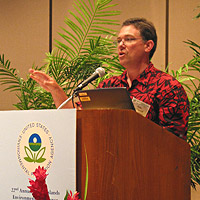
Manager, Pacific Islands Office, EPA
EPA staff notes: There is a great need for environmental protection in the islands. Major environmental problems are lack of adequate wastewater treatment and lack of safe drinking water. For example, 60 times more households in American Samoa lack complete plumbing facilities than in the mainland United States. China, Bangladesh, Thailand and the Philippines appear to have better access to safe drinking water and sanitation than some of the islands. Guam had eight months of boil water notices in 2001-2002. Saipan’s tap water is too salty to drink and not available 24 hours a day. These problems could cost $300 million and $90 million to fix, respectively. Public health is at risk. Solid waste is also a problem exacerbated by limited space and financing on islands. The first and only fully compliant municipal landfill in the Pacific territories has just been constructed. Due to the history of military activity on the islands, thousands of unexploded ordnance are regularly found. Illegal dumping, leaking underground storage tanks, and non-point source pollution are also significant environmental problems. The islands’ coral reefs are fragile and need protection.
Economic factors also hinder environmental progress on the islands. The economy lags behind the U.S. mainland and is and dependent on few industries. Maintenance of existing infrastructure is not performed as often as is needed in a tropical climate. Additionally, funding for water and wastewater projects is disproportionately low for small islands. The smallest U.S. state receives more funding than all the Pacific islands combined. Because of the serious problems and limited resources, it’s important that EPA work closely with local agencies to help protect the environment.
The Challenges of Environmental Protection
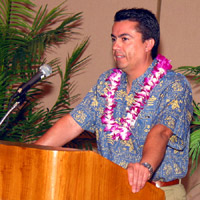
EPA staff notes: The position of regional administrator is very challenging and involves demands of the position as well as the demands of environmental issues. Situations such as 9/11 have arisen that require immediate yet sustained response from the agency. Good leadership is needed for effective results; leaders need to have the ability to say what is right and then do it. There is also a challenge in making people understand that despite our successes much valuable environmental work still needs to be done.
Safe drinking water, drinking water infrastructure, and air quality are vital. Enforcement is also one of the challenges of environmental protection, and helps protect people who comply with the law. No one should be able to benefit by breaking the law, and an economic price must be paid for non-compliance with environmental laws.
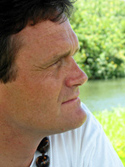
EPA staff notes: A command and control approach to environmental protection has its limits. The regulated community should participate in the process. A good example is the situation in Silver Valley, Idaho, where EPA partnered with the city to implement local solutions to local problems.
Keynote Address: The New South Seas Bubble: Sustainability and Its Alternatives
Dennis Hayes (dhayes@bullitt.org)Founder of Earth Day, CEO of the Bullitt Foundation
EPA staff notes: We are currently experiencing an ecological bubble comparable to other bubbles in the past, such as the South Seas Bubble, Tulipmania and the recent High Tech Bubble.
Today’s ecological bubble is caused by not factoring environmental impact into economic or political decisions. This ecological bubble leads to political and economic bubbles of increasing consequence. The difference in wealth between rich and poor people in the world today is greater than that between the pharaohs and serfs in Egypt or the disparity that caused the French Revolution. The extent of the ecological bubble is vast. One-hundred and fifty times as much area is trawled as is clear cut, but little attention is drawn to it because it is underwater and out of sight for most people. Ninety percent of the large fish species fisheries have collapsed. Our ecosystems are endangered: one-eighth of birds, one-fourth of mammals, and one-third of fish are endangered.
The population pressure on the earth needs to be alleviated to improve environmental conditions. It was noted that David Pimentel has projected that the planet can sustainably support 1.2 billion people at today’s consumption rates. For the planet and its people to survive, the hidden environmental costs of our current consumptive lifestyles will have to beaccounted for and our waste streams reduced significantly.
Sustainability in an Island Setting
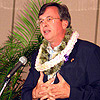
Mayor, City and County of Honolulu, HI
EPA staff notes: People living on islands innately understand that resources are finite and there is a need for sustainability. Islands are the world in microcosm. Technology is needed as well as informed, caring and bold leadership. An island can be destroyed much quicker in modern times. Hawaii is the extinction capital of the world. The need for sustainable practices is particularly important today. Sustainable tourism is tourism that enhances the culture and environment that people are coming to visit.
Coral Reefs: Status of Reefs in the Pacific
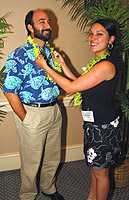
University of Guam
EPA staff notes: Reefs have great economic value which extend beyond the obvious benefits for fisheries. They also protect islands from storms, have museum/tourism, cultural, and medicinal value. Reefs thrive in nutrient-poor environments, and anthropogenic inputs of nutrients wreak havoc on a reef ecosystem. Poor land use, over-fishing, pollution, human physical contact, and global climate change negatively impact reefs. Urban run-off and sewage outfalls cause poor coastal water quality in the form of increased nutrients, pollutants and decreased light penetration through suspended sediments. Reef resource exploitation is leading to severe ecosystem changes and problems for reefs. For example, overfishing of algae-eating herbivorous fish leads to algal overgrowth, and the death of the corals that are shaded out.
Recent studies show that coral spawning is being interrupted. Interrupted spawning and/or poor age diversity in the coral community is an indicator of an unhealthy coral ecosystem. Although many people speak of coral reef restoration, it is not the answer. The conditions must be livable for restoration to be effective. When studying reefs, we face the problem of the shifting baseline. People compare conditions from 10-30 years ago to the present, using the conditions from 10-30 years ago as the baseline, but these reefs were already compromised at the time. The solution to these problems must include better enforcement of existing laws, targeted legislation compatible with coral reef ecosystems, and a strong seashore protection plan.
Coral Reef Ecosystem
Frank Tirendi, (f.tirendi@aims.gov.au)
Australia
Institute of Marine Science
EPA staff notes: The institute researches water quality impacts on the Great Barrier Reef. Water quality and coral reef health is influenced heavily by anthropogenic activities such as: mining, aquaculture, agriculture, tourism, fishing and shipping industries. Changes in temperature and water quality have led to a 5% increase in carbon dioxide levels on reefs. This has major implications for coral chemistry and solubility of carbonates corals use to build more coral. The Great Barrier Reef experienced a larger coral reef bleaching event in 2002 than in 1998, thereby casting doubt on the hypothesis that El Niño causes coral bleaching.
Coral Bleaching
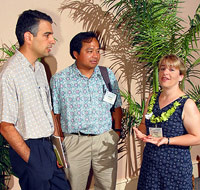
Office of Research and Development, EPA
EPA staff notes: It is often stated that coral reefs are the rainforests of the sea, yet corals existed first. So rainforests are actually the coral reefs of the land. Our current environmental regulations often are not appropriate with respect to their impacts on coral reefs. For example, temperate water quality criteria are often used in the tropics where they are not relevant. There should be more locally developed and applied regulations. Another example is use of a chemical specific endpoint, whereas a biological endpoint would be a better approach as it would take into account whether a soup of different low level chemicals can still affect organisms.
Integrating Sustainable Economies
David Schaller (schaller.david@epa.gov),Sustainable Practices and State Partnerships Program, EPA
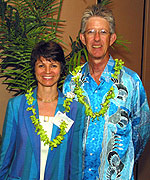
David Schaller, EPA Sustainable Devevelopment Coordinator
EPA staff notes: The ZERI organization was presented and its history, goals, objectives and projects around the world discussed. ZERI provides a nature-based systems framework for designing projects in which there is no waste, where all outputs from processes becomes inputs for other processes until there are no longer outputs.
By looking at the world with the right lens, one can always find ways to turn waste streams into value-added products for another industry. For example: a biological separation system has been invented that breaks down the constituent parts of CDs, DVDs, and tetrapak (i.e. polycarbonates, aluminum, PET, cardboard, metals) with a bath of algae, enzymes and bacteria at ambient pressure and temperature.
Jane Poynter (jpoynter@seawaterforests.org),
The Seawater Forests Initiative
EPA staff notes: In this project in the east African country of Eritrea, they are creating a way that people can farm food, restore habitat, and live off a desert coast where little water, food or fuel is available. An agricultural system run by women of small villages is created using a combination of mangroves, seawater and a finfish aquaculture. Mangrove restoration is being used to create food for animals, allowing valuable by-products to be produced and sold. Carbon offset credits from a major airline are being used to help fund the mangrove restoration work. We should not just be aiming for sustainability, but rather enhancement of people’s lives and surroundings.
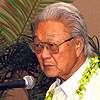
Zero Emissions Research and Initiatives (ZERI)
EPA staff notes: Information was presented on sustainable and pollution-free ways to use piggery wastes in an integrated farming system. The system uses pig excrement in an anaerobic digester to produce biogas. The bio-gas in this case was being used to sterilize substrate for mushroom culture. The excrement was also used for fertilizer. Without this method the feces from small piggeries would contaminate the local water supply. Instead, they are used to stimulate the economy with new industries such as mushroom culture, fish and crop production, and mangrove crab habitat restoration.
Amelia Terrapin, (amelia@onewest.net)Zero Emissions Research and Initiatives (ZERI)
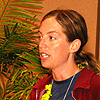
EPA staff notes: The Zero Emissions Research and Initiatives looks to take into account all inputs and outputs from agricultural and industrial systems, emulating nature in the creation of value-added products at each step in the process. Just as nature does not have a concept of waste, the waste from one ZERI system is used as the “food” for another. ZERI looks at local problems and comes up with economically, ecologically and socially sustainable systems. Examples included: sustainable rice farming in Brazil, innovative methods for extracting high-value products from the coconut industry, and the Gaviotas project in eastern Colombia.
Thursday, June 26, 2003
Waste and Wastewater: Public vs. Public
Facilitator: Enrique Manzanilla,
Director, Cross-Media Division,
EPA
Morrison & Foerster LLP
lobrien@mofo.com
EPA staff notes: Although the world is mostly covered with water, only 0.6% of water on earth is available for human use. Many people do not have the water they need for a healthy life; 1.5 billion people lack access to safe drinking water, and 4 billion do not have sanitation. Bad water leads to disease and death which have social and economic costs. Despite the frequent invocation of water as “Blue Gold,” the new highly profitable commodity, it has been difficult to get the private sector involved. The major barriers to privatization of water is the commonly held belief that water is an entitlement and the responsibility of local governments. Local governments are often unfamiliar with the benefits of privatization. Additionally, anti-globalization sentiment opposes the privatization of water. Water is therefore an intensely local and political issue.
Why privatize? The private sector has more capital, and the ability to make money. The pay-as-you-go public funding strategy does not work for a capital intensive industry.
When will privatization work? Privatization does not necessarily mean privatization of the whole system. Private companies can take over water capture, operations and maintenance, finance, or the whole system. The political will must match the degree of privatization in a particular community. It is necessary to be practical rather than ideological in making it work.
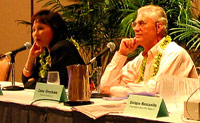
Honolulu Board of Water Supply
EPA staff notes: All public agencies out-source some of their functions. The current public sector is actually a public/private blend. People want to reform the public sector to be more efficient and effective. Privatization is often mistakenly viewed as a cure-all. The water board is taking innovative measures and trying to adopt the best practices of the private sector. They are looking at their sustainable water resources including watershed management modeled after the Hawaiian concept of “ahupua’a.” The board is also looking into alternative reuse, desalinization, conservation and decreased demand. They are fostering water reclamation, for example, as a public-private partnership. The Asia Pacific Urban Institute is helping the board re-engineer the board under QUEST, a flexible human resources program that is working with the unions.
The public sector needs to be more dynamic and adopt the best practices of the private sector.
Beyond Regulation: Incentives for Pollution Reduction
Facilitator: Laura Yoshii,Deputy Regional Administrator, EPA Region 9
Pollution Reduction Incentives, Recycling and Green Purchasing

Office of Pollution Prevention and Solid Waste, EPA
EPA staff notes: There are many ways to reduce, reuse and recycle waste streams. The islands do not have to re-invent the wheel; there is plenty of information available from EPA about programs that have already been implemented elsewhere and how to set them up.
For example, Saipan has started a pilot project in which no port fees are assessed for recyclables being shipped to be recycled. Saipan is eyeing an advanced disposal fee to encourage companies to be more responsible with the products they bring to Saipan. Nationally, construction and demolition accounts for 30-40% of the waste stream. California has started a successful new recycling and reuse program for this waste that can be emulated by others.
Incentives to Reduce Non-Point Source Pollution
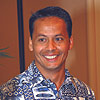
Conservation Society of Pohnpei,
Federated States of Micronesia
EPA staff notes: The Conservation Society of Pohnpei is taking a “Ridges to Reef” approach to watershed management and conservation. They have established an ecological reserve and are now demarcating the boundaries and effectively stopping illegal agriculture in the reserve. An agro-forestry program is underway to stabilize the landscape and prevent erosion while creating jobs and revenue. Their pig-waste program helps people modify their pigpens to divert the refuse from streams to agricultural fields. The society has established a marine protection area and is starting an environmental education program. One major hurdle is lack of manpower to carry out projects, and activities such as demarcating and patrolling the reserves.
Field trips to the Pacific Bio Diesel, H-Power, and to the Honouliluli Wastewater Reclamation facilities were made Thursday afternoon.
Friday, June 27, 2003
Solid Waste Success Stories
Facilitator: Laura Yoshii,
Deputy Regional Administrator, EPA Region
9
Kwajalein Atoll’s Recycling Program

Environmental Management Office
Phil Malloy, (phil.malloy@krs.usaka.smdc.army.mil)
Solid Waste Coordinator,
U.S. Army Kwajalein Atoll, Republic of the Marshall Islands,
EPA staff notes: Kwajalein Atoll is a series of islands in the Republic of the Marshall Islands, which is leased by the U.S. for military purposes. The atoll’s largest island is 1.2 square miles of area, and the atoll supports a population of 2,500 non-Marshallese and 12,000 Marshallese.
Over the past few years, due to the high amount of waste produced, the landfill reaching capacity and limited incinerator capacity, the military base was forced to implement a plan of reduction of the waste stream, direct reuse and recycling. They managed to reduce 40% of their waste stream by composting and recycling. Glass is reused by grinding it into sand and now the base does not need to purchase sand from the mainland. Metals and aluminum are shipped off the island for recycling. Their program’s success can be attributed to their unique situation in which there is almost total compliance with the recycling program on the base. They will soon begin mining their landfill for the metals in the incinerator ash. Kwajalein will soon have a shrinking landfill. The governments of neighboring Marshall islands, such as Ebeye Island and Majuro Atoll, have asked Kwajalein for assistance in their solid waste and recycling/reuse programs.
Saipan’s New Landfill
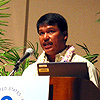
Lt. Governor, Commonwealth of the Northern Mariana Islands (CNMI) and
Steve Hiney, Solid Waste Manager, CNMI
fmsablan@saipan.com
EPA staff notes: The new Marpi Landfill on Saipan, which opened early this year, is the first fully compliant municipal landfill in the Pacific territories. The siting and building of this landfill took many years, involving several changes of administrations and many political twists and turns. The new landfill can accept up to 100 tons of waste per day and diverts 3-5 tons/day to recycling. The Puerto Rico Dump, closed when the Marpi Landfill opened, sits on the edge of Saipan Lagoon near the main tourist district, and was an eyesore for many years, impacting the lagoon as well as the air quality. It was a race against time to finish the new landfill before the dump reached its capacity.
Other solid waste problems on Saipan which are being addressed include unauthorized dumping, developing an Advanced Disposal Fee program for imported goods that result in a large waste stream which end up at the landfill, and recycling more waste streams. Advice from the Lt. Governor: Make a firm decision, do not deviate from it, fund it, and let professionals carry it out, not politicians.
Integrated Waste Management in the Islands
John Harder (mailto:John.Harder@co.maui.hi.us),Solid Waste Manager, County of Maui, HI

EPA staff notes: Solid waste is a monumental problem of mankind, as evidenced by Freshkills Landfill, which is visible from outer space, and is the largest landfill in the world. It is a dubious monument to our modern consumer society. Islands need to take control of their solid waste before it overwhelms them. Some examples for islands to take note of which have been successful in curbing waste generation and disposal are the following: Hawaii’s new bottle bill; requiring a recycling program for businesses with liquor licenses; incoming material fees; and, take-back/ship-back programs. For recycling programs to work well, there needs to be a top down commitment to them. Support from our leaders is vital.
Infrastructure Financing
Facilitator: Laura Yoshii,
Deputy Regional Administrator, EPA Region
9

International Center for Environmental Finance
EPA staff notes: Key message: utilize the concept of revolving funds to leverage financing, not grants. One needs to create a climate of assurance for investors and then private capital can help with many environmental projects. Despite a commonly-held belief that water should be free, people are willing to pay for water and they do pay for it already. There have been success stories in Africa with small scale water operations. By making the accounting of these water systems publicly available, honesty and efficiency is ensured. The benefits of revolving funds are 1) once granted the funds cannot be touched; and, 2) the funds grow or revolve. The funds are lent between little less than market rate down to 0%. They can also be leveraged and used as collateral for other loans. There is no need to rely on grants; if there is a social need then a project can be financed without grants.
David Cohen, (david_cohen@ios.doi.gov)Deputy Assistant Secretary, Office of Insular Affairs,
Department of the Interior (DOI)
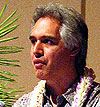
EPA staff notes: The Office of Insular Affairs offers a variety of sector grant programs to the freely-associated states under the new Compact of Free Association: education, health, infrastructure, environment, and private and public sector development. DOI also provides capital improvement funds to the territories as well as funding for technical assistance and improved operations and maintenance of their infrastructure. The territories are economically vulnerable because of their lack of a diversified economic base and reliance on just a few industries. Tuna processing is the major industry in American Samoa; Guam relies on tourism and the military; and the CNMI’s two industries are garment factories and tourism. Climate change can jeopardize the tuna industry, and world trade threatens the garment industry. Additionally, many of these islands are subject to frequent typhoons. Island representatives were urged to attend an economic development conference to be held in Washington, DC in September. Mr. Cohen, along with DOI Secretary Gale Norton, promote communication, consultation, and cooperation for conservation.
Managing Climate Risks in the Pacific: Challenges and Opportunities
Eileen Shea,East West Center, University of Hawaii
EPA staff notes: Climate change will have a great impact on Pacific islands because islands are physically vulnerable to changes in weather, and economically vulnerable due to their dependence on climate-sensitive resources. A rise in sea level and an increase of 1.3 degrees is anticipated by 2034. This is expected to produce an increase in precipitation overall but leave some areas drier. The frequency of extreme weather events which can have severe impacts on islands is expected to increase. Islands may also be affected if an increase in ocean temperature affects island fisheries and coral reefs ecosystems. Access to freshwater may be the biggest public health issue on islands. The center advocates planning for extremes (particularly droughts), integrating climate forecasts into decision making, and emphasizing self-sufficiency in long-term planning.
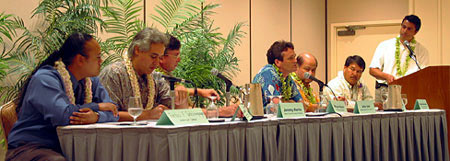
Panel: Sustainability in the Islands
Facilitator: Wayne Nastri,Regional Administrator, EPA Region 9
Panelists:
- Lt. Governor Diego Benavente, CNMI
- David Cohen, Deputy Assistant Secretary, DOI
- Jeremy Harris, Mayor, City and County of Honolulu
- John Iani, Regional Administrator, EPA Region X
- Fred Castro, Administrator, Guam Environmental Protection Agency
- Toetasi Tuiteleleapaga, Assistant Legal Counsel, Office of the Governor, American Samoa
- Culture needs to change. Previously, it was a moral sin to break the rules, now there is a "tragedy of the commons" regarding environmental issues. An attitude of, "If I don't break this rule, then someone else will," is found among people caught breaking bans on harmful fishing practices.
- We need to foster pride in a conservation ethic. Island cultures had their own systems of protecting areas, such as the Hawaiian "kapu" system.
- David Cohen called on the islands to develop their priorities and then ask for help.
- John Iani emphasized the need for good science that is "politics proof".
- Wayne Nastri praised voluntary measures programs such as the Energy Star program.
- Mayor Harris pointed out that the strictness of environmental laws may have unintended consequences and advocated flexibility when appropriate.
Additional resources:
- Agenda (PDF) (6 pp, 235K, About PDF)
- Pacific land-based pollution workshop
- Field Trips
- Environmental awards
- Hawaii (press release 4/21/03)
- Pacific Islands (press release 4/21/03)
